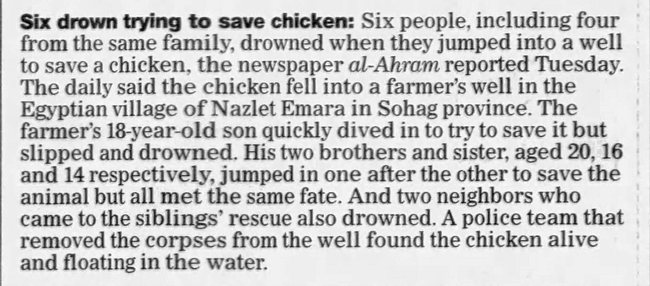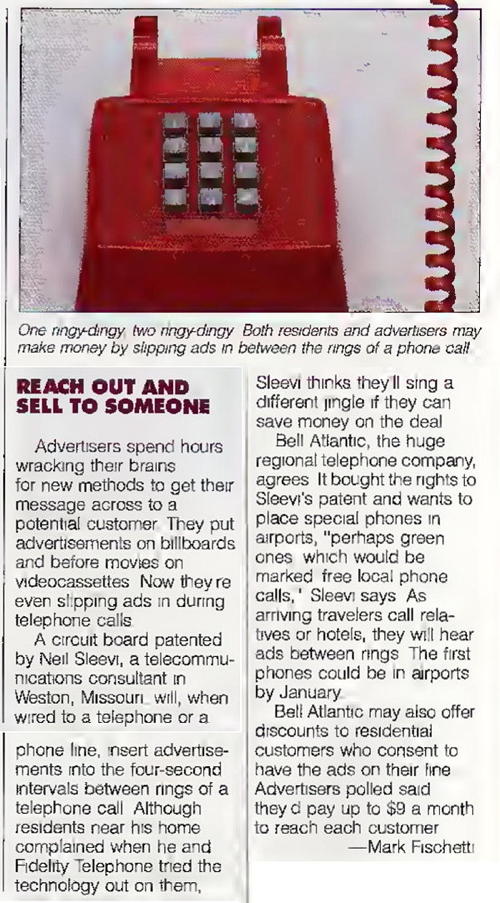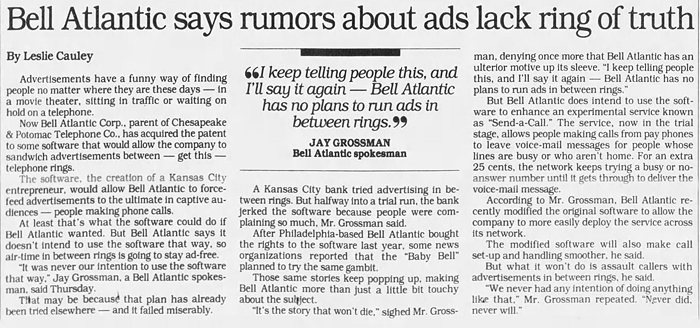1990s
Harley-Davidson Perfume
Classic business failure: "Hot Road," an eau de toilette released by Harley-Davidson in the mid-1990s and quietly discontinued a year or two later. It wasn't exactly an "on brand" product.More info: Milwaukee Magazine


image source: parfumo.net
Posted By: Alex - Sun Sep 18, 2022 -
Comments (0)
Category: Business, Products, Success & Failure, 1990s, Perfume and Cologne and Other Scents
Six drown trying to save chicken
Actually, only one of them jumped into the well trying to save a chicken. The others were trying to save humans. But still, it was a mass tragedy apparently started by an attempt to save a chicken.
Edmonton Journal - Aug 2, 1995
Posted By: Alex - Mon Apr 04, 2022 -
Comments (1)
Category: Animals, Death, 1990s
Self-Witness
1979: Thomas Martin, an assistant manager at a Jack in the Box restaurant, told police he was robbed of $307 while closing up the store. Police asked him to describe the robber. He described himself. He later confessed to taking the money from the store.I wonder if this sketch is preserved somewhere in the archives of the Oroville, CA police department.

Kenosha News - Mar 9, 1979
Posted By: Alex - Thu Mar 03, 2022 -
Comments (1)
Category: Stupid Criminals, 1990s
Robbing a glue factory
I assume they got the charges to stick.
Decatur Herald and Review - Nov 28, 1993
Posted By: Alex - Thu Feb 24, 2022 -
Comments (2)
Category: Stupid Criminals, 1990s
Understanding the Law: The Worm
Understanding the Law: The Worm, Diane Obomsawin, provided by the National Film Board of Canada
Posted By: Paul - Sun Feb 13, 2022 -
Comments (2)
Category: Law, Lawsuits, PSA’s, Cartoons, 1990s
Fingos
A classic business failure. In the early 1990s, the marketing team at General Mills came up with the idea of a cereal that could be eaten without milk any time of day. Despite spending millions to promote it, hardly anyone bought the stuff.From Wikipedia:
As the Gone But Not Forgotten Groceries blog notes: "All cereals can be eaten by hand if you don't add milk."
Posted By: Alex - Tue Feb 08, 2022 -
Comments (2)
Category: Business, Cereal, 1990s
The Tennessee Head Banger
Tom Myslinski, who was an offensive lineman for the Tennessee Volunteers, had an unusual pre-game ritual. He would psych himself up by banging his head against doors, cabinets, walls, towel dispensers, etc. Without a helmet.One of his teammates explained that he did this "until his eyes get all bloodshot and, then, blood is pouring from his forehead."
Myslinski noted, "It's just my way to pick up the intensity. To tell you the truth, I have no idea why I do it. Afterwards, sometimes, I say to myself that it sure was stupid because my head hurts."
Myslinski went on to play for nine seasons in the NFL and is now a strength and conditioning coach for the Jacksonville Jaguars.

Kingsport Times - Nov 20, 1991

Arizona Republic - Dec 27, 1991
Posted By: Alex - Mon Feb 07, 2022 -
Comments (2)
Category: Rituals and Superstitions, Sports, 1990s, Brain Damage
Keeping a promise
I'd call this a misguided sense of honor.
Billings Gazette - Aug 30, 1991
Posted By: Alex - Fri Feb 04, 2022 -
Comments (1)
Category: Crime, 1990s, Ethics and Morals
Anti-Blond Crusade
The Mean Girls of Apeldoorn:
Chicago Tribune - Feb 15, 1996
Posted By: Alex - Tue Jan 18, 2022 -
Comments (4)
Category: Antisocial Activities, 1990s, Hair and Hairstyling
Ads between telephone rings
I can only imagine how annoying it would be to have to listen to advertisements between rings whenever you phoned someone. And unfortunately the technology to do this has been developed. Neil Sleevi was granted a patent for it in 1989 (Patent No. 4,811,382), and Bell Atlantic promptly bought the rights to it.
Faced with public outcry, Bell Atlantic subsequently claimed that, even though they did buy the rights to the patent, they never had any intention of inserting ads between telephone rings, dismissing the entire notion as a silly rumor. But I'm pretty sure they would have done it if they had thought they could get away with it.

Baltimore Sun - Dec 14, 1991
Posted By: Alex - Sun Jan 02, 2022 -
Comments (5)
Category: Technology, Telephones, Advertising, Patents, 1990s

| Who We Are |
|---|
| Alex Boese Alex is the creator and curator of the Museum of Hoaxes. He's also the author of various weird, non-fiction, science-themed books such as Elephants on Acid and Psychedelic Apes. Paul Di Filippo Paul has been paid to put weird ideas into fictional form for over thirty years, in his career as a noted science fiction writer. He has recently begun blogging on many curious topics with three fellow writers at The Inferior 4+1. Contact Us |




